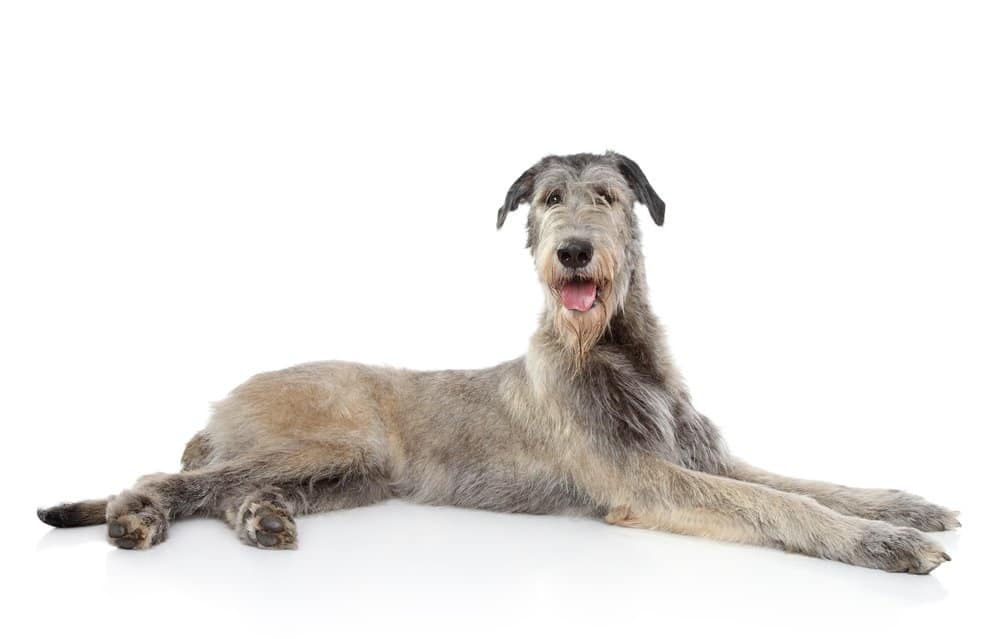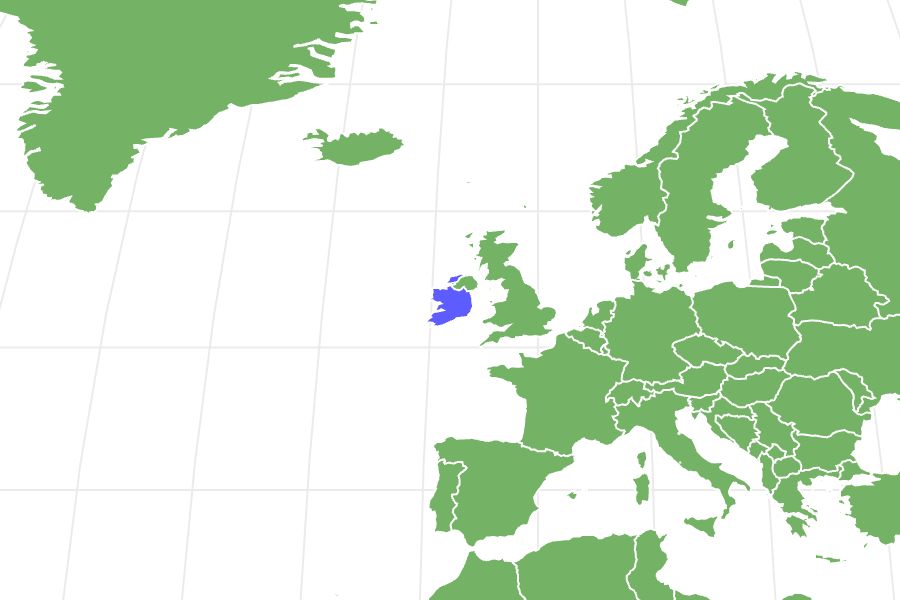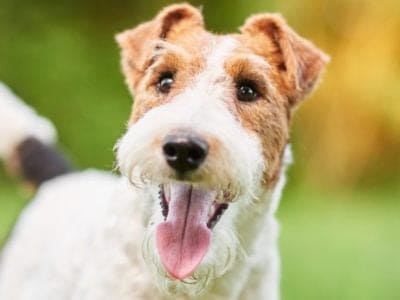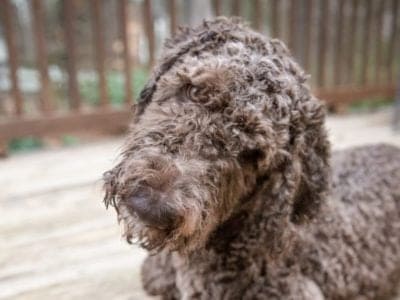Irish WolfHound
.jumbotron {
background-image: url(“https://a-z-animals.com/media/animals/images/original/irish_wolfhound-400×300.jpg”);
}
}
@media only screen and (min-width: 641px) and (max-width: 920px) {
.jumbotron {
background-image: url(“https://a-z-animals.com/media/animals/images/original/irish_wolfhound-470×370.jpg”);
}
}
@media only screen and (min-width: 921px) {
.jumbotron {
background-image: url(“https://a-z-animals.com/media/animals/images/original/irish_wolfhound.jpg”);
}
}
Sweet-tempered, patient and thoughtful!
Irish WolfHound Scientific Classification
- Kingdom
- Animalia
- Phylum
- Chordata
- Class
- Mammalia
- Order
- Carnivora
- Family
- Canidae
- Genus
- Canis
- Scientific Name
- Canis Lupus
Read our Complete Guide to Classification of Animals.
Irish WolfHound Conservation Status
Irish WolfHound Facts
.checked {
color: yellow;
}
Irish WolfHound as a Pet:
- General Health
- Energy Level
- Shedability
- Trainability
- Intelligence
- Tendency to Chew
- Size
- Family and kid friendliness
- Yappiness / Barking
- Low
- Separation Anxiety
- Low
- Preferred Temperature
- Average climate
- Exercise Needs
- Moderate
- Friendly With Other Dogs
- Poor
- Pure bred cost to own
- $1,500 and 2,000
- Dog group
- Hound
- Male weight
- -161 lbs
- Female weight
- -132 lbs
This post may contain affiliate links to our partners like Chewy, Amazon, and others. Purchasing through these helps us further the A-Z Animals mission to educate about the world’s species..

Spiders that fly! Fish that walk! And 1000+ more incredible animals. Discover them all for FREE
.photo-gallery {
–margin: 0px auto 0px;
–padding: 0px 0px 0px 0px;
}
.gallery-link {
background-image: url(“https://a-z-animals.com/media/Irish-WolfhoundCanis-familiaris.jpg”);
background-repeat: no-repeat;
background-size: cover;
background-position: center;
height: 500px;
justify-content: center;
text-align: center;
align-items: center;
display: flex;
border: 2px solid #000;
}
.gallery-link img {
height: 50%;
}
@media only screen and (max-width: 768px) {
.gallery-link {
height: 300px !important;
}
}
View all of the Irish WolfHound images!
Irish wolfhounds have a long and storied history. Depending upon who you ask, the breed traces back to as early as 700 BC.
The first examples of this breed were created by crossbreeding large British dogs with coursing hounds from the Middle East. These dogs were legendary for their large size and hunting abilities.
See all of our expert product reviews.
In fact, Irish clans used this breed as war dogs during the fierce battles of the Middle Ages. They were often regarded as gentle giants with their owners but fierce fighters while working or while on the hunt. During the 1700s, Irish farmers and hunters chose this breed to help them control the rampant wolf population in the countryside, hence their name.
button.pulse {
transform: scale(1); animation: pulse 2s infinite;
box-shadow: 0 0 0 0 rgba(11, 247, 25, 1);
}
@keyframes pulse {
0% { transform: scale(0.90); box-shadow: 0 0 0 0 rgba(11, 247, 25, 0.5); }
60% { transform: scale(1); box-shadow: 0 0 0 15px rgba(11, 247, 25, 0); }
100% { transform: scale(0.90); box-shadow: 0 0 0 0 rgba(11, 247, 25, 0); }
}
Unfortunately, these ancestral Irish wolfhounds did their job too well. By the 1860s the wolves in Ireland had gone extinct, and this dog breed had nearly disappeared. At that time, George Graham, a British army captain, searched Ireland for any remaining Irish wolfhounds and made it his goal to do what he could to protect the breed. He is still well-revered for his work in protecting the breed.
Irish wolfhounds are sighthounds, which means they are able to use their keen eyesight and fast speeds to hunt. They are known for their very dignified, calm, and courageous temperament.
3 Pros and Cons of Owning an Irish Wolfhound
| Pros! | Cons! |
| Calm These dogs have a very calm and gentle temperament, making them a good pet for the whole family. |
Expensive Taking care of this breed can be expensive. Since they are so large, be prepared to spend more money on food, medication, and pet supplies. |
| Quiet This dog breed does not bark very often, so you won’t need to worry about being disturbed by constant barking anytime anyone walks by your house. |
Shorter lifespan On average, these dogs only live between 6 and 10 years. This is a short amount of time compared to other breeds and won’t give you as much time to enjoy your furry friend. |
| Easy to groom These dogs don’t shed a lot. Their coats only need to be brushed about once a week. |
Not great for very young children The large size of this breed is a reason to think carefully before bringing one around babies and toddlers. They could accidentally injure or scare young children. |

Jagodka/Shutterstock.com
Irish Wolfhound Size and Weight
Irish wolfhounds are large dogs and are thought to be the tallest breed of dog. Males are at least 32 inches tall, but normally closer to 36 inches, and females are at least 30 inches tall, but typically closer to 33 inches. A fully grown male weighs around 160 pounds and a fully grown female weighs around 130 pounds. A 2-month-old puppy typically weighs around 24 pounds. By 6 months, male puppies are nearly 100 pounds and female puppies are around 90 pounds. They are fully grown by the time they are three years old.
Health and Entertainment for your Irish WolfHound
See all of our expert product reviews.
| Height | Weight | |
| Male | 36 inches | 161 pounds |
| Female | 33 inches | 132 pounds |
Irish Wolfhound Common Health Issues
If you are considering adopting one of these dogs, there are a few common health issues you should be aware of. It is also important to note that they may not ‘complain’ when something is bothering them, which can make it more challenging to determine that something is wrong.
Irish wolfhounds may develop cancer. Osteosarcoma is a bone tumor most often found in the limbs, but it can also be found in the bones in a dog’s spine, ribcage, or even skull. Some Irish wolfhounds also develop heart disease. This can include dilated cardiomyopathy. Oftentimes, your vet will be able to treat this disease.
This breed can also be impacted by gastrointestinal issues known as bloat, or torsion, which would need to be treated immediately. Pneumonia is another health concern to be on the lookout for. Finally, before bringing home an Irish wolfhound puppy, make sure they have been screened for a liver shunt, which is a developmental disorder.
To recap, some of the most common health issues Irish wolfhounds face are:
- Cancer
- Heart disease (including dilated cardiomyopathy)
- Bloat, or torsion
- Pneumonia
- Liver shunt
Irish Wolfhound Temperament
These dogs are known for their courageous behavior. However, they also do not have an aggressive personality, making them a good dog to have around children. They are also very calm dogs. This trait also makes them a good family pet. However, if you are going to have an Irish wolfhound around small children, you’ll still want to be sure to closely supervise simply because of how large these dogs are.
Another one of the traits that define this breed is their easygoing nature. While they will typically listen to what you are asking them to do, it may take some time. While an Irish wolfhound will be well-behaved inside, it is always a good idea to be extra aware when you are outside with them. They are hunters by nature, so they may spot an animal and try to chase it.
How to Take Care of an Irish Wolfhound
If you bring home one of these dogs, there will be a few key things you’ll want to consider when planning their care. Being aware of their health needs, dietary and nutritional needs, and other aspects of the care they’ll need will set you up for success with your new furry friend.
The Best Dog Food for Irish Wolfhounds
Since they are very large dogs, be prepared for them to eat a lot of food. For both puppies and adults, it is best to feed them numerous small meals throughout the day, rather than a few large meals. Puppies can overeat if you give them too much food at anyone meal, which could cause them to get sick.
When selecting food for your puppy, you want to choose natural foods that are very low in calcium and have few to no added supplements. Raw diets or high-quality kibbles will be your best bet for your Irish wolfhound puppies.
Unlike puppies, adult Irish wolfhounds are able to self-regulate. This means that they only eat when they’re hungry and won’t overeat. Once your puppy is an adult, you could choose to continue feeding them small meals throughout the day, or you could switch to free feeding and let your dog eat when he’s hungry.
When selecting food for your fully grown Irish wolfhound, you’ll also want to look for quality foods. A raw diet or adult kibble made with high-quality ingredients can also work for an adult Irish wolfhound. When creating your dog’s diet, you should try to include about 25% protein and 15% fat. Keep this breed’s vulnerability to heart disease like dilated cardiomyopathy in mind. Legumes in dog food have been linked to heart failure, so you may opt for legume-free dog food.
Our selection at A-Z Animals of the best dog food for Irish Woflhounds is Purina Pro Plan Large Breed & Giant Breed Chicken & Rice Adult Dry Dog Food.
This food contains none of the worrisome legumes like lentils and peas that you want to avoid with an Irish Wolfhound. Instead, there’s real chicken, fish, and beef, natural sources of taurine which sustains a strong heart. Since this breed can experience pneumonia and cancer, we love that this large breed recipe also has amino acids, prebiotic fiber and live probiotics for an immune system boost.
You can find Purina Pro Plan Large and Giant Breed dog food on amazon.
- One (1) 34 lb. Bag – Purina Pro Plan High Protein, Digestive Health Large Breed Dry Dog Food, Chicken and Rice Formula
- Glucosamine and EPA, an omega-3 fatty acid, for joint health and mobility
- High protein promotes muscle conditioning when combined with proper exercise
- High level of protein, combined with proper exercise, helps promote muscle conditioning
- 100 percent complete and balanced nutrition for adult dogs
Irish Wolfhound Maintenance and Grooming
This breed relatively easy to take care of as far as grooming goes. Their hair does not get matted. However, you will want to brush them a few times a week and pull out dead hairs about two times each year. Without doing this, your dog will look pretty scraggly.
Unlike other dogs that can leave hair all over your house, Irish wolfhounds do not shed. You will want to keep an eye on their beard and clean it regularly since it will get dirty when the dog eats.
Irish Wolfhound Training
Irish wolfhounds are relatively easy to train. They respond best to positive reinforcement. When choosing a training method, you’ll want to look for one that centers around positively reinforcing your dog. You may find that your Irish wolfhound puppy is clumsier and doesn’t listen as well, but after they are a year old this shouldn’t be a problem anymore.
Irish Wolfhound Exercise
Irish wolfhounds need between 20 and 40 minutes of exercise each day. When your dog is still a puppy, it is important to make sure that they don’t get too much exercise to damage their growing bones, ligaments, and joints that are still softer.
It is also very important to avoid exercising your dog right around the time they eat. Since Irish wolfhounds are at risk of bloat, giving them exercise right before or after a meal can be dangerous.
Irish Wolfhound Puppies

Jolanta Beinarovica/Shutterstock.com
There are a few things you’ll want to keep in mind if you are thinking about adopting a puppy. First, remember that these dogs are very large dogs, so that small puppy you bring home will be growing very quickly. They are slow to mature, so be prepared to deal with puppy behaviors, from a large dog, for quite some time.
You’ll definitely want to be prepared to sign your puppy up for a training class. If they aren’t well-trained, they can cause a lot of damage simply due to their large size, even if they aren’t trying to get into trouble.
When raising an Irish wolfhound puppy, it is also important to be aware that their joints and bones still have a lot of developing to do. Because of this, you want to be careful to limit how much exercise they get and take care to prevent stressing their joints.
Irish Wolfhounds and Children
This breed can make a great family dog. However, due to their large size, they would be best suited for a home with older children. These dogs could accidentally knock down or scare babies or toddlers.
This dog breed is very gentle and loving with children. It will still be important to make sure your children know how to appropriately touch the dog and how to safely play with them. As with other dog breeds, supervising your child when they are near your Irish wolfhound will be important to ensure everyone’s safety.
Dogs Similar to Irish Wolfhounds
Greyhounds, Great Danes, and bloodhounds are three dog breeds that are similar to an Irish wolfhound.
• Great Dane: Great Danes and Irish wolfhounds are two of the largest dog breeds. There is sometimes debate about which breed is the largest. In general, Great Danes weigh more than Irish wolfhounds, but an Irish wolfhound is taller than a Great Dane.
• Greyhound: Greyhounds and Irish wolfhounds are both very large dogs. Additionally, both of these dogs are sighthounds, which means they use their eyes to help them spot the prey they are looking to hunt.
• Bloodhound: Irish wolfhound are also similar to bloodhounds, like an Irish bloodhound. Both of these dogs were bred to be hunting dogs and are quite large in size. However, an Irish wolfhound weighs more and is taller than an Irish bloodhound.
• Scottish Deerhound: A Scottish deerhound is another breed that is very similar to the Irish wolfhound. These dogs can be hard to distinguish from Irish wolfhounds because of their large size and similar coloring. However, Irish wolfhounds are taller and more muscular than Scottish deerhounds. They also have a longer and slightly curved tail, whereas a Scottish deerhound has a tail that tapers and nearly touches the ground.
Popular Names for Irish Wolfhounds
Not surprisingly, many of the most popular names for this breed come from Gaelic or other Celtic languages and are rooted in Irish traditions or history. These names include:
- Aodh, pronounced oogh or Hugh, which means Celtic god of fire
- Anluan, pronounced on-lin, which translates to great hound
- Cathal, pronounced Cahool, which means mighty in battle
- Conan, or hound
- Connor, which translates to lover of hounds
- Madadh, or dog
- Onchu, which means mighty dog
Famous Irish Wolfhounds
As one of the largest, if not the largest dog breeds, there are a few ‘famous’ Irish wolfhounds you might like to know about:
- Liam Hemsworth’s dog Dora: Dora is a Golden Doodle-Irish wolfhound mix that Liam rescued in 2015 when she was only 6 months old.
- John F. Kennedy: When he was president, John F. Kennedy had an Irish wolfhound named Wolf. Wolf was a gift from Father Thomas Kennedy, a priest in Ireland.
Last update on 2022-07-06 / Affiliate links / Images from Amazon Product Advertising API
View all 29 animals that start with I
Irish WolfHound FAQs (Frequently Asked Questions)
Are Irish Wolfhounds good pets?
Yes, Irish Wolfhounds are good pets. They are calm and easy-going dogs who are good with children.
Can an Irish Wolfhound kill a wolf?
Yes, Irish Wolfhounds could kill a wolf. It would be pretty unlikely to happen today, but these dogs were trained to hunt wolves in Ireland in the 15th century. By the end of the 1700s, they had made the wolves in Ireland go extinct.
How much does an Irish Wolfhound cost to own?
If you purchase an Irish Wolfhound from a breeder, you should expect to spend between $1,500 and 2,000. However, you could spend $3,000 or more is you are looking for a show-quality dog.
In addition to the breeder fees, there are also expenses you should be prepared for when adopting an Irish Wolfhound. Since these dogs are so large, they need to eat a larger quantity of food than other dogs, which will be more expensive. They’ll also need larger doses of medication if they get sick and a larger dog bed and other supplies. Be prepared to spend more money taking care of an Irish Wolfhound than you would a smaller breed dog. You’ll want to budget at least $500 a year for taking care of your dog.
How tall is an Irish Wolfhound? Why are they so big?
Irish Wolfhounds are the tallest dog breed. Males are at least 32 inches tall, but most are closer to 36 inches tall, and female are at least 30 inches tall, but often closer to 34 inches tall. They used to hunt wolves, so they would need their large size to be able to survive when hunting.
Are Irish Wolfhounds good with kids?
No, Irish Wolfhounds do not bark very often. Even though they are quite large, they would not make a great guard dog because of their quieter nature.
Do Irish Wolfhounds bark a lot?
No, Irish Wolfhounds do not bark very often. Even though they are quite large, they would not make a great guard dog because of their quieter nature.
Yes, Irish Wolfhounds are good with kids. They are gentle and calm, which makes them a good family pet. You may want to consider waiting until your children are a little older to adopt an Irish Wolfhound, though. Because of their large size, these dogs could accidentally injure a baby or toddler.
How long do Irish Wolfhounds live?
Irish Wolfhounds have an average lifespan of between six and ten years. According to the Irish Wolfhound Club of Ireland, the longest living example of this breed was Killykeen Kildevin. This dog lived to be 16.5 years old.
Are Irish WolfHounds herbivores, carnivores, or omnivores?
Irish WolfHounds are Omnivores, meaning they eat both plants and other animals.
What Kingdom do Irish WolfHounds belong to?
Irish WolfHounds belong to the Kingdom Animalia.
What class do Irish Wolfhounds belong to?
Irish Wolfhounds belong to the class Mammalia.
What phylum to Irish WolfHounds belong to?
Irish WolfHounds belong to the phylum Chordata.
What family do Irish Wolfhounds belong to?
Irish Wolfhounds belong to the family Canidae.
What order do Irish Wolfhounds belong to?
Irish Wolfhounds belong to the order Carnivora.
What type of covering do Irish Wolfhounds have?
Irish Wolfhounds are covered in Hair.
What genus do Irish Wolfhounds belong to?
Irish Wolfhounds belong to the genus Canis.
What is an interesting fact about Irish Wolfhounds?
Irish Wolfhounds are sweet-tempered, patient, and thoughtful!
What is the scientific name for the Irish Wolfhound?
The scientific name for the Irish Wolfhound is Canis Lupus.
What are the differences between an Irish Wolfhound and a Great Dane?
The key differences between the Irish Wolfhound and the Great Dane are appearance, size, health risk, and temperament. Great Danes are frequently larger dogs, although Irish wolfhounds generally are taller.
Although the Irish Wolfhound originated in Ireland and the Great Dane originated in Germany, most experts say that the Great Dane’s genealogy is a cross between the English Mastiff and the Irish Wolfhound.
What’s the difference between a Wolf and an Irish Wolfhound?
Irish wolfhounds are bigger than wolves, and they were originally bred to hunt this apex predator. Additionally, wolves live longer lives on average compared to the Irish wolfhound.
Sources
- American Kennel Club, Available here: https://www.akc.org/dog-breeds/irish-wolfhound/#:~:text=About%20the%20Irish%20Wolfhound,a%20whole%20lot%20of%20hound
- Pet Helpful, Available here: https://pethelpful.com/dogs/great-gaelic-dog-names-for-an-irish-wolfhound
- Pernille Monberg, Available here: https://dev.paffen.no/articles/healthlongevity.php#:~:text=The%20oldest%20recorded%20Irish%20Wolfhound,Irish%20Wolfhound%20club%20of%20Ireland
- Irish Wolfhound Club of America, Available here: https://www.iwclubofamerica.org/puppy-growth
- Irish Wolfhound Club of America, Available here: https://www.iwclubofamerica.org/health
- Feeding My Dog Breed, Available here: http://www.feedingmydogbreed.com/feeding-irish-wolfhounds.html
- Vet Specialists, Available here: https://vetspecialists.co.uk/fact-sheets-post/canine-osteosarcoma-fact-sheet/#:~:text=Osteosarcoma%20in%20dogs%20is%20a,like%20mammary%20glands%20and%20muscle.https://www.hillspet.com/dog-care/dog-breeds/irish-wolfhound
- Petful, Available here: https://www.petful.com/breeds/breed-profile-irish-wolfhound/#:~:text=Irish%20Wolfhounds%20are%20easy%20to,is%20not%20a%20guarding%20breed.
- Dogtime, Available here: https://dogtime.com/dog-breeds/irish-wolfhound#:~:text=Irish%20Wolfhounds%20are%20gentle%20with,to%20homes%20with%20older%20children.&text=With%20early%20socialization%20and%20training,along%20well%20with%20other%20dogs.
- Your Purebred Puppy, Available here: https://www.yourpurebredpuppy.com/reviews/irishwolfhounds.html
- Bubbly Pet, Available here: https://www.bubblypet.com/how-much-does-an-irish-wolfhound-cost/

























